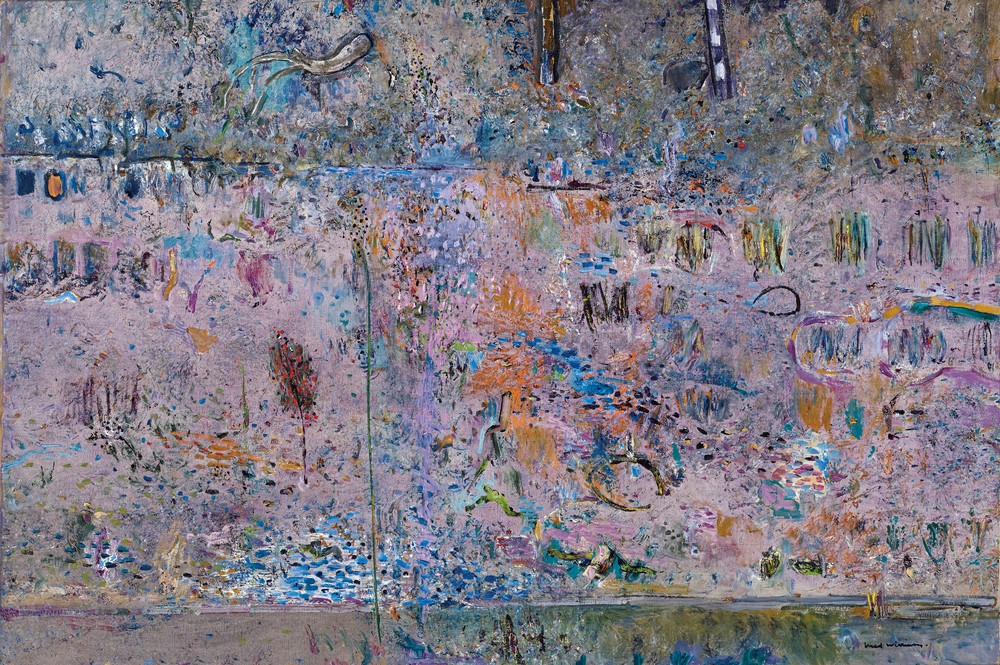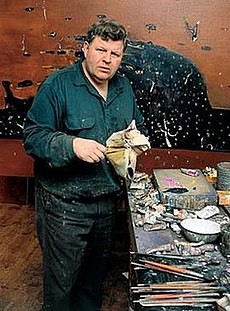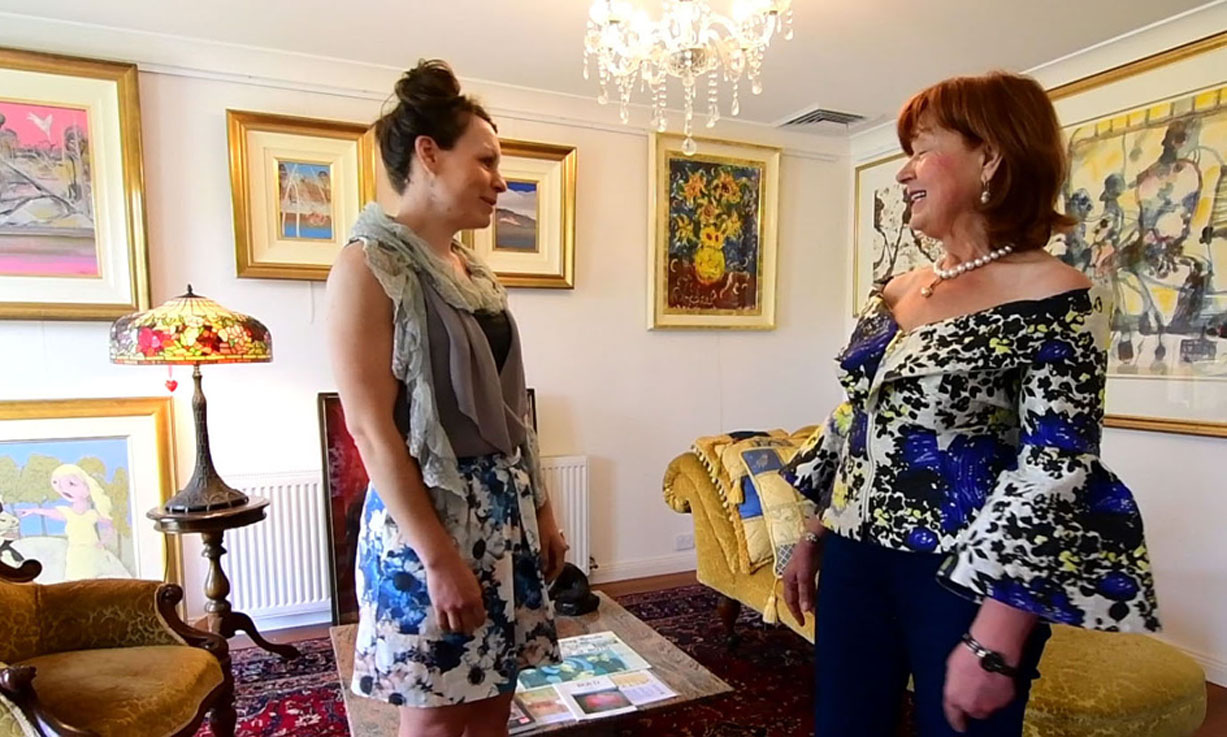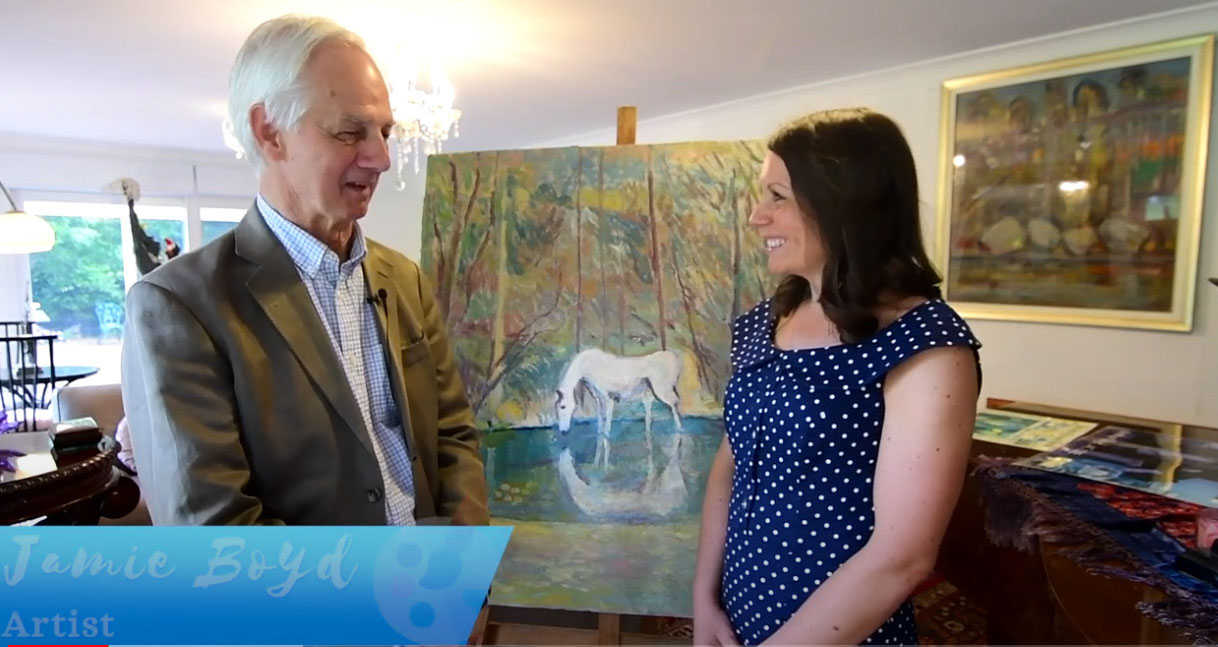Frederick (Fred) Ronald Williams 1927–1982
|
|
If you love Art of
impeccable
provenance, the
Art
you want is at
Galeria Aniela.
|
|
Fred
Williams is one of the most important Australian artists. His contemporary
panoramic
landscapes were inspired by the vast
Australian land. Williams developed a
ground-breaking, expressionistic style of seeing Australian
landscape.
Williams portrayed his landscape vision in an individual,
bird's-eye view an abstract representation.
Highly valued internationally,
Fred Williams work is held in
important museums including Tate Gallery London, Metropolitan
Museum of Art New York, National Gallery of Victoria.
Fred Williams died in 1982, aged
55. Williams left
a limited body of work, much smaller than
Brett
Whiteley,
Arthur Boyd, and
John
Perceval. |
|
|

Billabong River, 1976
Oil on canvas
122.5 x 182.5 cm
Price: SOLD
|
|
Fred Williams is a Blue-chip artist with a solid reputation for creating art
that increases in value over time. Blue-chip art usually sells for the highest
price at auctions and become a valuable investment.
In August
2023
auction house
Smith & Singer sold
Masons Falls
for
$3,190,909. |
|
|
|
Please
contact us
if you consider buying or selling an original work of
Fred Williams,
Arthur Boyd,
Brett Whiteley,
Charles Blackman,
Garry Shead,
John Perceval
or another significant work of fine art.
|
|
|
|
|
|
Fred Williams
Biography
Frederick Ronald Williams OBE (23
January 1927 – 22 April 1982)
Fred Williams was
the major landscape
artist, Australia’s
most important
painter and printmaker.
Williams
had
the exhibition at the Museum
of Modern Art in New
York in
1977 - 'Landscapes of a Continent'
and seventy solo exhibitions during his career in Australian galleries.

From 1943 to 1947 he studied at the National
Gallery School,
Melbourne, at first part-time and then full-time from 1945 at the age of 18. The
Gallery School was traditional and academic, with a long and prestigious
history. He also began lessons under George
Bell the
following year, who had his own art school in Melbourne. This continued until
1950. Bell was a conservative modern artist but a very influential teacher.
Between 1952 and 1956, Williams
studied part-time at the Chelsea School of Art, London (now Chelsea
College of Art and Design)
and in 1954 he did an etching course at the Central
School of Arts and Crafts.
Williams
returned to Melbourne in 1956.
Williams work included in an
exhibition at the Whitechapel
Gallery,
London, and 'Australian Painting: Colonial, Impressionism, Modern' at the Tate
Gallery.
As an artist concerned with form
over subjectivity, Williams approach struck a jarring note against the unity of
many of his close associates such as John
Brack, Arthur
Boyd and Charles
Blackman,
the authors of the famous ‘Antipodean’ manifesto of 1959.
William’s work was excluded from
their major exhibition. As heirs to the expressionist tradition,
the Antipodeans lauded a spontaneous, improvised approach to painting and saw
the function of art as vested in its expressive potential. They had little time
for - and, in fact, denounced - the 'new' art emerging from Europe, the
influences which were increasingly informing Williams' development.
On his return to Australia, Williams
saw the aesthetic potential
of the Australian bush in its inherent plasticity. His interest in finding an
aesthetic 'language' with which to express the very un-European Australian landscape.
This was grounded in establishing a pictorial equivalent to the overwhelmingly
vast, primarily flat landscape, in which the traditional European relationship
of foreground to background breaks down, necessitating a complete re-imagining
of compositional space.
In this, Williams looked to the approach taken by Australian
Aboriginal artists.
Williams did this by tilting the
landscape up against the picture
plane,
so that frequently the only indicator of horizontal recession is the presence of
a horizon line,
or where clumps of trees huddle closer together towards the horizon, suggesting
recession. Where no horizon is visible, the landscape runs fully parallel to the
picture plane, as in the major You
Yangs series
of the mid-1960s. Here, calligraphic knots of pigment indicate the presence of
single trees against the earth, as if seen from the air.
In 1960, Williams was invited to
enter for the Helena
Rubenstein Travelling
Art Scholarship, the richest and most prestigious art prize at the time with an
award of £1000 plus £300 travel expenses aimed at giving the winner overseas
experience.
Five paintings were required for his
entry and he selected Landscape with a steep road (1957),
Landscape with a building I (c.
1957–58), The forest pond (c. 1959–60), Sherbrooke Forest (1960) and The St
George River (1960).
Williams won in 1963 and it proved
to be a turning point in his career which, according to fellow artist Jan
Senbergs, brought Williams wide acclaim, especially from many influential
curators and critics.
Sydney art dealer Rudy
Komon took
Williams on as one of his key artists which enabled Williams to discontinue his
part-time work with a Melbourne picture-framer and paint full-time.
In 1969, Williams started using a
horizontal strip format in his landscape paintings in order to present different
aspects of one scene on the same sheet.
In 1970, Williams produced a group
of four large strip format gouache-on-paper paintings called the West Gate
Bridge series showing the half-constructed West
Gate Bridge over
the Yarra
River in Melbourne.
A section of the bridge collapsed on
15 October 1970, while it was still under construction, killing thirty-five
workers. In his Beachscape with bathers Queenscliff I-IV series from 1971,
Williams painted from the top of a cliff overlooking the beach during a seaside
holiday. By 1971 he had developed the technique extensively, moving from a
vertical format to a horizontal format.
In March 1974, Williams travelled
to Erith
Island in Bass
Strait with
the historians Stephen
Murray-Smith and Ian
Turner,
and fellow painter Clifton
Pugh. Poor
weather prevented Williams and his friends from leaving the island when they had
intended. When the weather broke Williams painted a number of gouaches,
including Beachscape, Erith Island I and II which employ the horizontal strip
format.
The Beachscape, Erith
Island pictures show the point where the sea joins the land depicted as if
looking down from above in the form of four strips.
Williams recorded the event in his
diary from 27–28 March 1974, "I do 'strip' paintings of the beach using sand
glued on – but the wind has worn me to a 'frazzle' … My final half doz. strip
paintings are my best."
In May 1976, while Williams and his
wife Lyn were visiting Paris and Bologna, many of Williams's paintings and all
gouaches stored at the Barrett Malt Factory in Richmond were damaged by a fire.
In 1976, Williams flew over the
Northern Territory at night on his way to an art fair in Bologna, Italy.
He saw lines of bushfires burning and later that year produced the
twelve-sheeted gouache series, Bushfire in Northern Territory.
In February 1979, Williams visited
the Lal Lal Falls on the Moorabool
River to
the west of Melbourne near Ballarat and
painted the Lal Lal polyptych, a four panel painting that he regarded as a
single work.
The successive canvases of the
polyptych depict the changes in light on the waterfall and the surrounding
landscape.
Williams painted the last of his
major landscapes, the four panel Waterfall polyptych (oil on canvas, each
183.0 cm x 152.5 cm), in his studio in 1979 based on the Lal Lal polyptych.
He described the studio painting as
"a major effort on my part" and it is regarded as one of the most important
works of his career. Williams said that his "enthusiasm was fired" by Eugene
von Guérard's Waterfall,
Strath Creek from
1862.
In the last years of his career,
Williams produced more landscape series with strong themes, his last being the Pilbara series
(1979–81), which remained intact as it was acquired by Con-Zinc Rio
Tinto Group,
the mining company that had invited him to explore the arid north-west region of
Australia.
In April 2006, Williams
painting Upwey Landscape (1965) sold for $1,987,700 in one of the
final auctions of Christie's in
Australia , which at the time was the second highest price for any
work sold at an Australian auction.
In September 2007, auction house Deutscher-Menzies broke
their sales record with Williams' Landscape with Water Ponds (1965) selling for
$1,860,000. The most expensive work sold at an Australian auction in 2009 was
Williams' 1965 Evening Sky, Upwey, which sold for $1.15 million. Two of
Williams' paintings, Dry Creek Bed, Werribee Gorge I (1977) and Drifting
Smoke (1981) were included in Quintessence Editions Ltd.'s 2007 edition of 1001
Paintings You Must See Before You Die.
Williams' work is also represented in
William Splatt's 100 Masterpieces of Australian Landscape Painting.
Williams
Hummock in Landscape
sold for
$2,822,727,
Lysterfield Landscape
sold for
2,331,818 and
You Yangs Landscape
sold for
$2,287,500.
In August
2023
auction house
Smith & Singer
sold
Williams
Masons Falls for
the highest price
$3,190,909.
Awards
1963 Williams received a Helena
Rubinstein Travelling
Art Scholarship.
1966 Williams won the Wynne
Prize for
landscape painting Upwey
1976 he was named an Officer of the Order
of the British Empire (OBE),
1976 Williams won the Wynne
Prize for
landscape painting Mt. Kosciusko
1980 awarded a Doctorate of Law (Honoris
Causa) by Monash
University.
|
|
|
|
Auction Results |
|
Details |
Price excl. GST |
|
 |
Masons Falls (1981)
Oil on canvas, signed 'Fred Williams' lower left
182.2 x 151.8 cm,
Est: $2,000,000-3,000,000, Smith & Singer, Important
Australian Art, Sydney, 23/08/2023, Lot No. 23 |
$3,190,909 |
|
 |
Hummock in Landscape, 1967
Oil on canvas, signed Fred Williams lower centre
153 x 122 cm, Est: $1,400,000-1,800,000, Deutscher and Hackett,
Important Australian & International Fine Art, Melbourne, 15/07/2020,
Lot No. 7 |
$2,822,727 |
|
 |
Lysterfield Landscape, 1968 – 69
Oil on canvas, signed Fred Williams lower right
182.5 x 152.5 cm, Est: $1,600,000-2,000,000, Deutscher and Hackett,
Important Australian + International Fine Art, Sydney, 14/09/2022, Lot
No. 3 |
$2,331,818 |
|
 |
You Yangs Landscape 1 1963
Oil on masonite, signed Fred Williams lower left
137 x 180.3 cm, Est: $1,500,000-2,000,000, Bonhams, The Grundy
Collection, Sydney, 26/06/2013, Lot No. 49 |
$2,287,500 |
|
 |
Hillside at Lysterfield II, 1967
Oil on canvas, signed Fred Williams lower centre
137.5 x 153 cm, Est: $1,500,000-2,000,000, Deutscher and Hackett, Twenty
Classics of Australian Art + Important Australian & International Fine
Art, Melbourne, 11/11/2020, Lot No. 8 |
$2,209,090 |
|
 |
Landscape with Water Ponds,
1965-67
Oil on canvas, signed lower left: Fred Williams
153 x 184 cm, Est: $1,400,000-2,000,000, Deutscher~Menzies, Australian
and International Fine Art, Sydney, 12/09/2007, Lot No. 38 |
$1,860,000 |
|
 |
Hillside Landscape No. 1 (1966)
Oil on canvas, signed Fred Williams lower centre,
152.5 x 121.4 cm, Est: $1,000,000-1,200,000, Sotheby's, Important
Australian & International Art, Sydney, 11/05/2016, Lot No. 142 |
$1,830,000 |
|
 |
Upwey Landscape
Oil on canvas, signed Williams 65' lower right
152.5 x 183 cm, Est: $500,000-800,000, Christies, Australian,
International & Contemporary Art, Melbourne, 10/04/2006, Lot No. 54 |
$1,807,000 |
|
 |
Hillside
Oil and tempera on composition board, signed lower right and inscribed
with title on the reverse
90.5 x 120.5 cm, Est: $500,000-700,000, Sotheby's, Important Australian
Art, Sydney, 07/05/2007, Lot No. 29 |
$1,800,000 |
|
 |
Mountain Creek, Mount
Kosciusko (1976)
Oil on canvas, signed Fred Williams lower left
182.5 x 111.7 cm, Est: $800,000-1,200,000, Sotheby's, Important
Australian Art, Sydney, 27/08/2019, Lot No. 11 |
$1,708,000 |
|
 |
Water Pond in a Landscape II
Oil on canvas, signed lower centre; bears title on label on the reverse
152.5 x 122 cm, Est: $380,000-500,000, Sotheby's, Australian and
International Art, Melbourne, 21/11/2006, Lot No. 5 |
$1,440,000 |
|
 |
Lysterfield (1968)
Oil on canvas, signed Fred Williams lower centre left
121.9 x 152.5 cm, Est: GBP300,000-500,000, Christies, Australian Art,
London, 26/09/2013, Lot No. 66 |
£829,875
($1,421,991) |
|
 |
Evening Sky, Upway, 1965
Oil on canvas, signed Fred Williams lower centre
135 x 130 cm, Est: $700,000-900,000, Deutscher and Hackett, Important
Australian + International Fine Art, Melbourne, 25/11/2009, Lot No. 14 |
$1,380,000 |
|
 |
Pool at Agnes Falls (1981)
Oil on canvas, signed 'Fred Williams' lower right
152 x 182.2 cm, Est: $800,000-1,200,000, Sotheby's, Important Australian
Art, Melbourne, 14/05/2013, Lot No. 18 |
$1,342,000 |
|
 |
Hillside I, 1965
Oil on linen, signed and dated '65 lower centre
134 x 152 cm, Est: $1,000,000-1,500,000, Mossgreen Auctions, The Estate
of Ann Lewis, AO (Art lots only), Sydney, 07/11/2011, Lot No. 85 |
$1,281,000 |
|
|
|
|

Galeria Aniela
provides an independent professional service
and experienced
guidance representing clients best interest in
the art market.
We welcome the opportunity to speak with you, please feel free to
contact us to discuss
ways in which Galeria Aniela can assist you now and in the future.
Whether you are a first-time buyer, an astute investor or
enthusiastic collector, our people focused approach ensures an
enjoyable and rewarding experience.

video | Galeria Aniela Fine Art broker
Combining a wide network of resources with
expertise in Australian fine art, we
assist clients in all aspects of acquisitions of fine art objects,
shipping worldwide,
ensuring impeccable
provenance
and
quality,
helping save
time and
money.
Testimonials
Founded in 1994, Galeria Aniela exhibited world-class artists
and received celebrities including
Sir David
Attenborough, Cameron
O’Reilly
and
Hon Bob Hawke,
Australian Prime Minister.
Galeria Aniela
built
a
strong
standing
in Australia and internationally.

Video |Jamie Boyd, the Boyd family most
important LIVING artist
The
BOYD family
exhibition
in Galeria Aniela
coup the
front page
Sydney Morning Herald,
Australian National NEWS| ABC TV
and
Sunday Afternoon |ABC TV.
John Perceval Retrospective won
the Australian National NEWS |ABC TV and
Charles Blackman Retrospective conquer
Australian
Art Scream |SBS TV.
Works of art live for generations, constantly reborn in the minds of
the beholders to bring new meanings, new dreams, new ways of seeing
and experiencing the world. Be part of this magic world of amazing
fine art from the ocean of tranquillity to
concur
the heart, mind and soul.
When you purchase Art from
Galeria Aniela,
you make a valuable contribution to our mission of helping artists
to make a living with their creations and together we make a
difference.
|
|
|
|
|